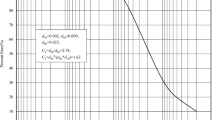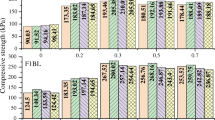Abstract
Due to the special soil-forming environment and process, grain-size distribution, and mineral composition, loess has some poor engineering properties, such as high compressibility, strong water sensitivity, and severe collapsibility. These poor properties lead to frequent occurrence of geological disasters and engineering problems in loess area, so loess is often strengthened in engineering projects. Compared with the traditional methods, the use of stabilizing agents has the advantages of saving time, reducing cost, and increasing efficiency. Therefore, more and more attention has been paid to the research on soil stabilizing agents. In this review, the non-traditional stabilizing agents which can effectively improve the physical and mechanical properties of loess are summarized, including nanomaterials, industrial waste residues, water-hardening inorganic materials, polymer, ion stabilizing agents, and so on. The composition, mechanism, effect, and application of each stabilizing agent are introduced. The mechanisms of strengthening mainly include filling, cementation, ion exchange, and wrapping. One or several of these mechanisms work together when loess is strengthened with any stabilizing agent. Based on this review, it is recognized that it is still meaningful to find eco-friendly and cost-effective loess stabilizing agents, and the focuses are now still on interpretation of the mechanism of each stabilizing agent, as well as determination of the physical and mechanical properties of strengthened loess. Attention should be paid to the degradation in the mechanical properties of strengthened loess and the technical innovation in application, as well as to solving the problems related to practical application of these stabilizing agents.













Similar content being viewed by others
References
Amin M, Abu El-Hassan K (2015) Effect of using different types of nano materials on mechanical properties of high strength concrete. Constr Build Mater 80:116–124
Behnood A (2018) Soil and clay stabilization with calcium- and non-calcium-based additives: a state-of-the-art review of challenges, approaches and techniques. Transp Geotech 17:14–32
Calvo-Flores FG, Dobado JA (2010) Lignin as renewable raw material. Chem Sus Chem 3(11):1227–1235
Chen RF, Tian GY, Mi DY, Dong XQ (2018) Study on basic engineering properties of red mud stabilized loess. Rock Soil Mech 39(S1):89–97 (in Chinese)
Chen RF, Dong XQ, Mi DY, Puppala AJ, Duan W (2019) Mechanical properties and micro-mechanism of loess roadbed filling using by-product red mud as a partial alternative. Constr Build Mate 216:188–201
Costantini EA, Carnicelli S, Sauer D, Priori S, Andreetta A, Kadereit A, Lorenzetti R (2018) Loess in Italy: genesis characteristics and occurrence. CATENA 168:14–33
Dijkstra TA, Rogers CDF, Smalley IJ, Derbyshire E, Li YJ, Meng XM (1994) The loess of north-central China: geotechnical properties and their relation to slope stability. Eng Geol 36(3–4):153–171
Eren S, Filiz M (2009) Comparing the conventional soil stabilization methods to the consolid system used as alternative admixture matter in Isoarta Daridere material. Constr Build Mater 23(7):2473–2680
Feng SJ, Du FL, Shi ZM, Shui WH, Tan K (2015) Field study on the reinforcement of collapsible loess using dynamic compaction. Eng Geol 185:105–115
Gao YY, Qian H, Li XY, Chen J, Jia H (2018) Effects of lime treatment on the hydraulic conductivity and microstructure of loess. Environ Earth Sci 77:529. https://doi.org/10.1007/s12665-018-7715-9
Garakani AA, Mohsen HS, Desai CS, Mohammad HSG, Sadollahzadeh B, Senejani HH (2019) Testing and constitutive modeling of lime-stabilized collapsible loess. I: experimental investigations. Int J Geomech 19(4):1–10
Ghadakpour M, Choobbasti AJ, Kutanaei SS (2020) Experimental study of impact of cement treatment on the shear behavior of loess and clay. Arab J Geosci 13(4):184. https://doi.org/10.1007/s12517-020-5181-7
Ghasabkolaei N, Choobbasti AJ, Roshan N, Ghasemi SE (2017) Geotechnical properties of the soils modified with nanomaterials: a comprehensive review. Arch Civ Mech Eng 17(3):639–650
He ZQ, Fan HH, Wang JQ, Liu G, Wang ZN, Yu JH (2017) Experimental study of engineering properties of loess reinforced by lignosulfonate. Rock Soil Mech 38(03):731–739 (in Chinese)
Hosseini A, Haeri SM, Mahvelat S, Fathi A (2019) Feasibility of using electrokinetics and nanomaterials to stabilize and improve collapsible soils. J Rock Mech Geotech Eng 11(5):1055–1065
Houston SL, Houston WN, Spadola DJ (1988) Prediction of field collapse of soils due to wetting. J Geotech Eng 114(1):40–58
Huang Y, Wang L (2016) Experimental studies on nanomaterials for soil improvement: a review. Environ Earth Sci 75(6):497. https://doi.org/10.1007/s12665-015-5118-8
Ikeagwuani CC, Nwonu DC (2019) Emerging trends in expansive soil stabilisation: a review. J Rock Mech Geotech Eng 11(2):423–440
Iranpour B, Haddad A (2016) The influence of nanomaterials on collapsible soil treatment. Eng Geol 205:40–53
Jha AK, Sivapullaiah PV (2015) Mechanism of improvement in the strength and volume change behavior of lime stabilized soil. Eng Geol 198:53–64
Kim S, Gopalakrishnan K, Ceylan H (2012) Moisture susceptibility of subgrade soils stabilized by lignin-based renewable energy coproduct. J Transp Eng 138(11):1283–1290
Kong R, Zhang FY, Wang GH, Peng JB (2018) Stabilization of loess using nano-SiO2. Materials 11(6):1014
Krishnan J, Shukla S (2019) The behaviour of soil stabilised with nanoparticles: an extensive review of the present status and its applications. Arab J Geosci 12(14):436
Li CQ, Liu QB, Xiang W, Wang QE, Qiao Y (2018) Anti-erodibility of loess subgrade slope reinforced with SH-polymer and inorganic material. J Yangtze River Sci Res Inst 35(8):90–94 (in Chinese)
Li JY, Wang JM (2019) Comprehensive utilization and environmental risks of coal gangue: a review. J Clean Prod 239:117946. https://doi.org/10.1016/j.jclepro.2019.117946
Li GY, Hou X, Mu, YH, Ma W, Wang F, Zhou Y, Mao YC (2019b) Engineering properties of loess stabilized by a type of eco-material calcium lignosulfonate. Arab J Geosci 12(22). https://doi.org/10.1007/s12517-019-4876-0
Li P, Xie WL, Pak RYS (2019a) Vanapalli SK. Microstructural evolution of loess soils from the loess plateau of China. CATENA 173:276–288
Li P, Vanapalli SK, Li TL (2016) Review of collapse triggering mechanism of collapsible soils due to wetting. J Rock Mech Geotech Eng 8(2):256–274
Liu DY, Wu CS (2012) Stockpiling and comprehensive utilization of red mud research progress. Materials 5(7):1232–1246
Liu JW, Fan HH, Song XY, Yang XJ (2020) Characteristics of shear strength and deformation of compacted Q3 loess. Soil Mech Found Eng 57(1):65–72
Liu SJ, Fan HH, Shi X, He ZQ (2014) Durability of stabilized soil by BCS. Journal of Northwest A & F University (Natural Science Edition) 42(12):214–220 (in Chinese)
Liu Z, Liu FY, Ma FL, Wang M, Bai XH, Zheng YL, Yin H, Zhang GP (2015) Collapsibility, composition, and microstructure of a loess in China. Can Geotech J 53(4):676–686
Lv QF, Chang CR, Zhao BH, Ma B (2018) Loess soil stabilization by means of SiO2 nanoparticles. Soil Mech Found Eng 4(6):409–413
Ma WJ, Wang BL, Wang X, Jiang DJ, Li ZY (2018) Experimental study on mechanical properties of modified loess. Water Resour Hydropower Eng 49(10):150–156 (in Chinese)
Mariri M, Ziaie MR, Kordnaeij A (2019) Stress–strain behavior of loess soil stabilized with cement, zeolite, and recycled polyester fiber. J Mater Civ Eng 31(12). https://doi.org/10.1061/(ASCE)MT.1943-5533.0002952
Mi DY, Song ZW, Huang FF, Dong XQ (2016) Influence of red mud on electrical resistivity and strength characteristics of loess solidified by cement. Sci Technol Eng 16(15):268–272 (in Chinese)
Ng CWW, Coo JL (2015) Hydraulic conductivity of clay mixed with nanomaterials. Can Geotech J 52(6):808–811
Nouaouria MS, Guenfoud M, Lafifi B (2008) Engineering properties of loess in Algeria. Eng Geol 99(1–2):85–90
Peng Y, Zhang HY, Lin CB, Wang XW, Yang L (2017) Engineering properties and improvement mechanism of loess soil modified by consolid system. J Rock Mech Eng 36(03):762–772 (in Chinese)
Pham H, Nguyen QP (2014) Effect of silica nanoparticles on clay swelling and aqueous stability of nanoparticle dispersions. J Nanopart Res 16(1):2137. https://doi.org/10.1007/s11051-013-2137-9
Ryashchenko TG, Akulova VV, Erbaeva MA (2008) Loessial soils of Priangaria Transbaikalia Mongolia and Northwestern China. Quat Int 179(1):90–95
Sarli JM, Hadadi F, Bagheri RA (2019) Stabilizing geotechnical properties of loess soil by mixing recycled polyester fiber and nano-SiO2. Geotech Geol Eng 38(2):1151–1163. https://doi.org/10.1007/s10706-019-01078-7
Semkin VV, Ermoshin VM, Okishev ND (1986) Chemical stabilization of loess soils in Uzbekistan to prevent building deformations. Soil Mech Found Eng 23(5):196–199
Shan ZJ, Zhang XC, Zhao WX, Chen ZG (2010) Effect of EN-1 stabilizing agent on soil anti-erodibility. Sci Soil Water Conserv 24(05):6–9 (in Chinese)
Sun Y, Lu HY, An ZS (2006) Grain size of loess palaeosol and Red Clay deposits on the Chinese Loess Plateau: Significance for understanding pedogenic alteration and palaeomonsoon evolution. Palaeogeogr Palaeoclimatol Palaeoecol 241(1):129–138
Tabarsa A, Latifi N, Meehan CL, Manahiloh KN (2018) Laboratory investigation and field evaluation of loess improvement using nano-clay - a sustainable material for construction. Constr Build Mater 158:454–463
Taha MR, Alsharef JMA, Al-Mansob RA, Khan TA (2018) Effects of nano-carbon reinforcement on the swelling and shrinkage behaviour of Soil. Sains Malays 47(1):195–205
Vinod JS, Indraratna B, Mahamud MAA (2010) Stabilization of an erodible soil using a chemical admixture. Water Energy Int 163:43–51
Wan JH, Sun HH, Wang YY (2009) Effect of red mud on mechanical properties of loess-containing aluminosilicate based cementitious materials. Mater Res 610:155–160
Wang JD, Xu YJ, Ma Y, Qiao SN, Feng KQ (2018) Study on the deformation and failure modes of filling slope in loess filling engineering: a case study at a loess mountain airport. Landslides 15(12):2423–2435
Wang JD, Zhang DF, Wang NQ, Gu TF (2019) Mechanisms of wetting-induced loess slope failures. Landslides 16(5):937–953
Wang P, Liu DY (2012) Physical and chemical properties of sintering red mud and Bayer red mud and the implications for beneficial utilization. Materials 5(10):1800–1810
Wang SJ, Han WF, Wang YM (2003) Testing study on loess consolidated by LD serial rock-soil cemedin. Chin J Rock Mech Eng C2:2888–2893 (in Chinese)
Wang YM, Li C, Teng F, Gao LC (2011) New research on chemical solidification of collapsible loess foundation. Appl Mech Mater 90:2466–2471
Wang YM (2016) Shear strength characteristics of loess stabilized by new polymer materials. Low Temp Archit Technol 212(02):122–124 (in Chinese)
Xue SG, Zhu F, Kong XF, Wu C, Huang L, Huang N, Hartley W (2016) A review of the characterization and revegetation of bauxite residues (red mud). Environ Sci Pollut Res Int 23(2):1120–1132
Xu J, Li YF, Wang SH, Wang QZ, Ding JL (2020) Shear strength and mesoscopic character of undisturbed loess with sodium sulfate after dry-wet cycling. Bull Eng Geol Environ 79(3):1523–1541
Yates K, Fenton CH, Bell DH (2018) A review of the geotechnical characteristics of loess and loess-derived soils from Canterbury South Island New Zealand. Eng Geol 236:11–21
Yu JC, Qian JS, Tang JY, Ji ZW, Fan YR (2019) Effect of ettringite seed crystals on the properties of calcium sulphoaluminate cement. Constr Build Mater 207:249–257
Zhang CL, Jiang GL, Su LJ, Zhou GD (2017) Effect of cement on the stabilization of loess. J Mt Sci 11(14):2325–2336
Zhang HY, Peng Y, Wang XW, Lin CB (2016a) Study on water entry and loss capacity of loess stabilized by hydrophobic agent. Rock Soil Mech 37(S1):19–26 (in Chinese)
Zhang T, Cai G, Liu S, Puppala AJ (2016b) Engineering properties and microstructural characteristics of foundation silt stabilized by lignin-based industrial by-product. KSCE J Civ Eng 20(7):2725–2736
Zhang LJ, Li Y, Liu HH (2016c) Experimental study on loess stabilization by composite BTS agent. Subgrade Eng 6:125–128 (in Chinese)
Zhang WF, Liu QB, CAI ST, (2009a) Testing study on loess consolidated by HEC soil stabilizer. Yangtze River 40(03):56–59 (in Chinese)
Zhang LP, Zhang XC, Sun Q (2009b) Study on capacity of improving loess anti-shear strength and anti-permeability of two kinds of ionic soil solidified agent. Water Sav Irrig 5:35–38 (in Chinese)
Zhang ZQ, Jing YL (2011) Mechanical properties of road base with roadbood EN-1. Adv Mater Res 255:3366–3370
Funding
The funding was received from the National Natural Science Foundation of China (42007251), the National Key Research and Development Plan (2018YFC1504703), the Shaanxi Key Laboratory of Loess Mechanics and Engineering (LME201803), the China Postdoctoral Science Foundation (2019M653883XB), and the Education Department of Shaanxi Provincial Government (18JK0785).
Author information
Authors and Affiliations
Corresponding author
Rights and permissions
About this article
Cite this article
Hou, Y., Li, P. & Wang, J. Review of chemical stabilizing agents for improving the physical and mechanical properties of loess. Bull Eng Geol Environ 80, 9201–9215 (2021). https://doi.org/10.1007/s10064-021-02486-x
Received:
Accepted:
Published:
Issue Date:
DOI: https://doi.org/10.1007/s10064-021-02486-x




